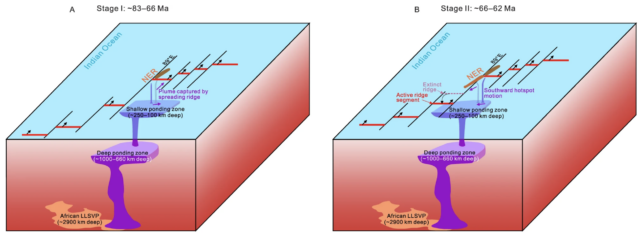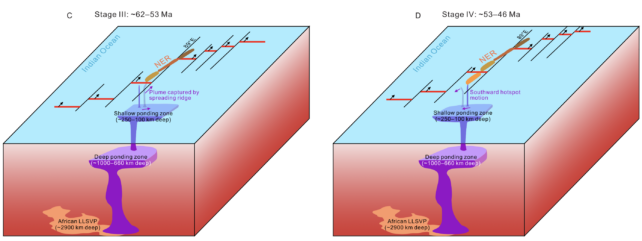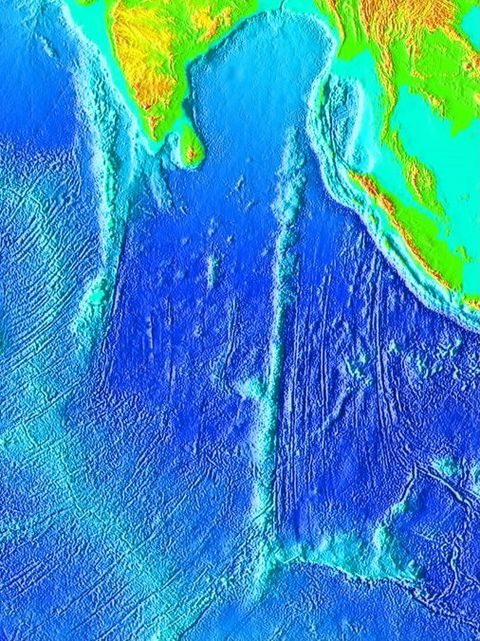The Indian Ocean is home to a mountain range longer than the North American Rockies, yet today all 5,000 kilometers (3,107 miles) of it lie hidden beneath the sea.
A new study digs deep beneath the waves to show how the Ninetyeast Ridge was formed between 43 and 83 million years ago – and its origins are quite a surprise.
Seamounts are underwater volcanoes found in every ocean. They are caused by ‘hotspots’ beneath the Earth’s surface, where accumulating heat melts away the mantle, releasing hot plumes in a pipe-like upwelling.
Initially, scientists didn’t think hotspots could move, so it was thought that a trail of underwater volcanoes was the result of tectonic plates sliding over the top of a stationary hotspot. Think of it as a sewing machine in reverse, with a stationary ‘needle’ of hot material piercing a cloth that slides above and sews a line.
It turns out that the submerged volcanic chain of the Indian Ocean formed in a different way. The hotspot in this case can better be imagined as a fountain pen, with the moving ‘point’ depositing liquid magma over the Earth’s surface.
“Unlike most volcanic hotspots that remain stationary in the mantle and create volcanic trails as tectonic plates drift over them, this study found that the hotspot responsible for the Ninetyeast Ridge has expanded hundreds of kilometers within the mantle over time.” shifted,” explains geoscientist Hugo Olierrook. Curtin University in Australia.
“This type of hotspot movement is believed to be common, but it is difficult to prove and has only previously been demonstrated for a few hotspots in the Pacific Ocean, making this the first documented case in the Indian Ocean.”

The Kerguelen hotspot is responsible for the creation of the vertical underwater scar of the Indian Ocean, and inconclusive studies have suggested that the hotspot has moved south or west over time.
Researchers in Australia, Sweden, China and the US have now analyzed basalt samples from the Ninetyeast Ridge to support that idea.

Their results suggest that the Kerguelen mantle plume formed when the Indian Plate began to drift north, opening the Indian Ocean.
If the Kerguelen hotspot had remained beneath the Indian plate during this movement, the ridge would have moved north at the same rate as seafloor spreading.
But that’s not what the team found.
Radioisotope dating suggests that the mountain range’s peaks formed between 83 and 66 million years ago at about half the rate of seafloor spreading.
This means that “the Kerguelen hotspot was not beneath the Indian plate,” writes the international team of researchers led by Qiang Jiang of the China University of Petroleum.
It is difficult to explain why the hotspot moved at this speed, but Jiang and colleagues argue that “the most likely scenario is that the mantle plume was captured by the northward-migrating Indian-Antarctic spreading ridge, and that plume material continuously flowed toward the spreading ridge and erupted on the ridge.”
About 66 million years ago the plume became “disconnected” when the spreading ridge began to drift too far away. Later, the plume was again temporarily captured, this time by the western spreading ridge.
About 42 million years ago, the hotspot had drawn a vertical line that now divides the Indian Ocean into east and west.

“For years, rough estimates of the age of the Ninetyeast Ridge have been used to construct models of how Earth’s tectonic plates moved and reconfigured,” says Curtin earth scientist Fred Jourdan.
“By using highly accurate dating, we can significantly refine these models, leading to better insights into ancient continental movements.”
The research was published in Nature communication.



/cdn.vox-cdn.com/uploads/chorus_asset/file/25765398/Screenshot_2024_11_29_at_3.14.40_PM.png?w=445&resize=445,265&ssl=1)